Hip Pain Can Be Very Serious – Learn To Treat Your Pain Felt In The Hip


What Is Hip Pain?
“Hip pain” is an all encompassing term that describes the general pain around the hip or inside the hip joint, and can even radiate to the glutes, groin or thigh. Residents of Burnaby, BC, experiencing hip pain can find comprehensive care and support close to home, with a range of treatments tailored to your specific needs.
What Are The Mechanics Of The Hip Joint?

The hip joint is composed of an intricate layer of muscles, tendons and ligaments that provide support and stability when walking, jumping, kicking, bending, and flexing.
In fact, it is one of the few joints in the human body that also carries the greatest range of motion, such that it has the ability to move in 360 degrees.
With its vast amount of functions, it is no wonder that the hip joint is susceptible to overuse and wear and tear with time. Accordingly, pain associated with injury can be short or long lasting, mild or severe, and can be insidious or due to an injury.
In addition, fluid filled sacs called bursae reduce the friction between the muscles, bones, and tendons with each movement, which can also be a source of hip pain when they get inflamed from overuse.
Therefore, it is important to be familiar with the symptoms and recognize the signs associated with hip pain to distinguish between a severe injury such as a labral tear, or even a life threatening condition such as a tumor.
Why Do People Experience Hip Pain?


As with any injury, hip pain can develop suddenly or be a chronic condition for people.
While there are a myriad of causes to how and why someone is experiencing hip pain ranging from overuse to underlying bone pathology, the two subgroups of hip pain are both acute and chronic pain.
More often than not, the location and pain intensity can help to indicate the source as well as mechanism of your pain.
What Are The Most Common Types of Acute Hip Pain?


The most common cause of acute hip pain is due to inflamed tendons (tendinitis) or muscles which can be brought on by too much exercise.
This will fortunately often heal within a few days with relative rest. Another reason for acute hip pain can be trauma to the area which may then result in a hip fracture particularly if there was underlying osteoarthritis or osteopenia which would have weakened the bone structure.
Soft tissue/vascular trauma can also elicit acute pain, but some people are still able to walk with associated skin changes (swelling and bruising) in the area.
What Are The Most Common Types of Chronic Hip Pain?


The causes of chronic hip pain include, but are not limited to, the following conditions: arthritis, bursitis, and hip fractures, with arthritis being the most common source of hip pain in older adults.
What Is Trochanteric Bursitis?


Although more common in women than in men, inflammation of the bursae in your hip can be brought on by poor posture, overuse, or an injury to the hip such as a previous hip fracture, resulting in pain that will reduce your range of motion.
Underlying conditions that are inflammatory in nature (rheumatoid arthritis, gout, psoriasis etc.) may also contribute to an increased prevalence of bursitis.
Typically pain is noticed when a patient has overused the soft tissue surrounding the bursa.
Treatment consists of splinting, physiotherapy/registered massage therapy, or non-steroidal anti-inflammatory drugs. If these conservative measures are not helpful, surgery may be considered.
What Is Tendinitis?


Tendinitis is an overuse injury that can result in inflammation or irritation of the thick bands of tissue that connect your hip muscles to the bone.
Typically this will occur when an individual partakes in activities that they have not done in many years, or due to repetitive strain injuries.
Oftentimes, general resting and icing can heal this injury in a few days. If the pain and swelling persist, it’s a good idea to visit your trusted health care practitioner.
What Is Hip Arthritis?


Hip arthritis, affectionately known as wear and tear arthritis, occurs when the cartilage that acts like a lubricant between the head of the femur and the acetabulum of the hip degrades.
There can be swelling, inflammation, and pain that proceed as a result.
Age, types of activity, in addition to your genetics, can predispose you to this type of injury.
With long periods of inflammation, there can be gradual degeneration of cartilage starting with pain that is mild, but will eventually become more noticeable as the bones lose their cushioning.
The pain can be felt more specifically in the gluteal area and radiate down to the groin/thigh or knee(s), affecting daily movements such as bending, walking, and or rising from a chair.
Finally, you may also experience some locking at the hip, sticking, or even a grinding sound (also known as crepitus) due to the loss of cartilage.
Treatment for arthritis could include relative rest, topical analgesics/anti-inflammatory medication, in addition to targeted physiotherapy/manual therapy. If all of these conservitive measures fail, surgery may also be explored.
Is It Possible To Strain My Hip Muscles?


As previously mentioned, since there is such a large degree of motion within the hip joint, they are kept in check by muscles, tendons and ligaments to keep the joint stable and strong.
Repetitive use, lack of a warmup, intrinsic stiffness, and/or improper movements can harm these tissues leaving you with a sore hip.
What Does A Hip Strain Feel Like?


A hip strain likely will feel like sharp pain, particularly with movement or when that specific muscle is working.
Typically, when the individual rests, the pain should dissipate with time. There can also be some soreness or dull achiness that is constant and in the background.
Although not completely debilitating, proper care and management of such an injury is important for a full recovery to the hip. This would include getting manual therapy, relative rest, and some strategic stretching/strengthening exercises.
What Is A Hip Capsule Injury?


So far in this post, we’ve spoken about the muscles that support the hip joint and allow it to transfer weight from the ground to our muscles allowing us to ambulate and be active.
However, there is a secondary piece of anatomy that is responsible for stability in the hip joint and that is the capsule, show via the ligaments in the picture above.
If the individual is lifting a heavy load, or if there is undue stress on the hip joint, the capsule can become stretches and since it has innervation, it can become painful.
Treatment often consists of soft tissue therapy, mobilizations, and targeted strengthening.
Since the capsule does not have a blood supply unlike muscles, injuries often take longer to heal and so it’s important the individual remains patient when working through these injuries.
Repetitive use, lack of a warmup, intrinsic stiffness, and/or improper movements can harm these tissues leaving you with a sore hip.
What Do I Need To Know About Hip Fracture?
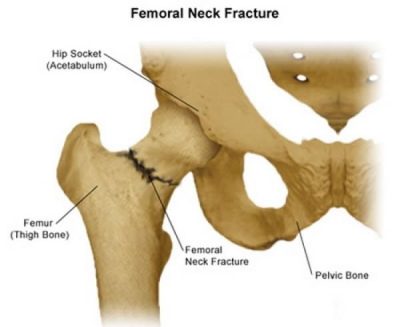

Hip Fracture – bones get brittle with age and are likely to break at the top of the thigh bone (femur) with falls that occur sideways, and tend to happen in women more often than men.
In addition, women are also more susceptible to weakening bones due to osteoporosis and hormonal changes.
Distance runners can also experience stress fractures which are thin cracks in the hip, which become deeper if left untreated.
Whether it be a full hip fracture or a stress fracture at the hip, some people are still able to walk and may experience only a dull pain around their hips, glutes, groin, thigh, and/or even back.
However, others may experience excruciating pain in the hip or groin areas and will not be able walk, with the additional swelling, bruising, or redness.
However, there is a secondary piece of anatomy that is responsible for stability in the hip joint and that is the capsule, show via the ligaments in the picture above.
If the individual is lifting a heavy load, or if there is undue stress on the hip joint, the capsule can become stretches and since it has innervation, it can become painful.
Treatment often consists of soft tissue therapy, mobilizations, and targeted strengthening.
Since the capsule does not have a blood supply unlike muscles, injuries often take longer to heal and so it’s important the individual remains patient when working through these injuries.
Repetitive use, lack of a warmup, intrinsic stiffness, and/or improper movements can harm these tissues leaving you with a sore hip.
Is Rheumatoid Arthritis Serious?
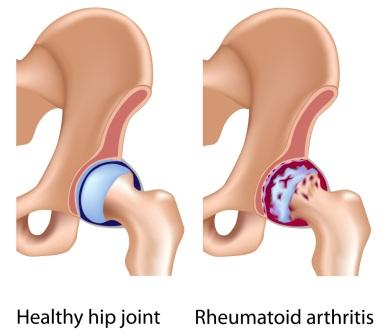

This type of arthritis is unique since it’s an autoimmune disease, and is caused when the patient’s body attacks itself.
Many joints can be affected, ranging from the hip, knee or even shoulder.
Episodes of pain may be sudden in onset, or come with activity or stress. Diagnosis often involves a blood test, in addition to imaging.
In addition, women are also more susceptible to weakening bones due to osteoporosis and hormonal changes.
Distance runners can also experience stress fractures which are thin cracks in the hip, which become deeper if left untreated.
Whether it be a full hip fracture or a stress fracture at the hip, some people are still able to walk and may experience only a dull pain around their hips, glutes, groin, thigh, and/or even back.
However, others may experience excruciating pain in the hip or groin areas and will not be able walk, with the additional swelling, bruising, or redness.
However, there is a secondary piece of anatomy that is responsible for stability in the hip joint and that is the capsule, show via the ligaments in the picture above.
If the individual is lifting a heavy load, or if there is undue stress on the hip joint, the capsule can become stretches and since it has innervation, it can become painful.
Treatment often consists of soft tissue therapy, mobilizations, and targeted strengthening.
Since the capsule does not have a blood supply unlike muscles, injuries often take longer to heal and so it’s important the individual remains patient when working through these injuries.
Repetitive use, lack of a warmup, intrinsic stiffness, and/or improper movements can harm these tissues leaving you with a sore hip.
How Can I Relieve Hip Pain Temporarily?
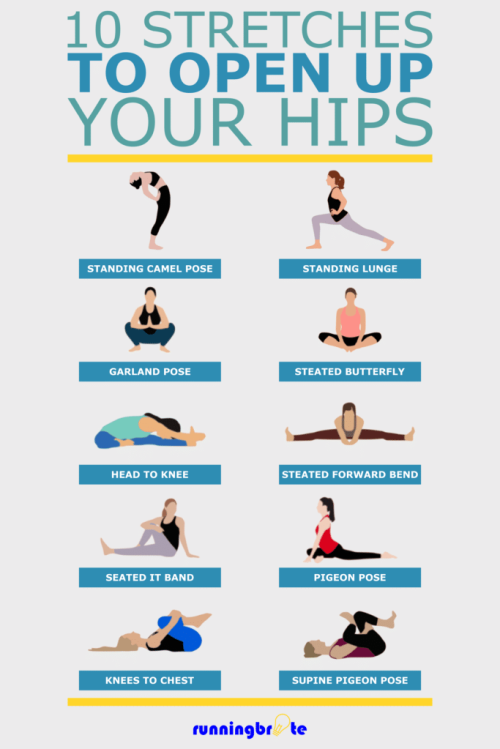

Due to the different types and causes of hip pain that this blog post has covered, myriad methods of pain relief can be recruited. The most common method that’s pursued by individuals is relative rest.
This is where the patient eases activities that exacerbate their pain, in the hopes of having the tissue heal on its own. More often than not, this can help in a meaningful way.
Pain relief can be sought through painkillers or anti-inflammatory drugs especially if the source of pain is related to a muscle strain, osteoarthritis, or tendinitis.
Icing or heating the area for approximately 15 minutes at a time is another excellent way to help reduce swelling.
For those in Burnaby and the surrounding areas, local parks such as Burnaby Mountain and Deer Lake Park offer gentle walking trails that can help maintain mobility without exacerbating hip pain. Additionally, Burnaby’s community centers provide various low-impact exercise classes suitable for those managing hip pain.
Stretching the area if there are tight muscles and joints can help to reduce stiffness/pain as well as increase mobility.
Please remember, new injuries and unusual symptoms should always be checked out by a registered health care practitioner as soon as possible to ensure the best chance of recovery and/or pain management. Learn more about what to do after accidents in our article on What To Do After A Car Accident Before It’s Serious?
When to Get Medical Attention For Hip Pain?
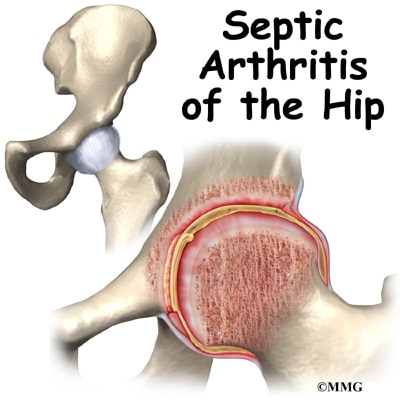

If your hip pain lasts longer than a few days it is best to seek medical care, as you may develop a limp that will stress other muscle groups and joints that can radiate pain to other areas of the body.
However, more severe pain and cases that include hearing a popping noise with movement, visible deformation or swelling, and/or being unable to bear weight, require immediate care.
Additionally, if any soreness, tenderness, warmth, and redness develop around the hip area, make sure to seek prompt medical care as this may be a sign of an infection.
Can Chiropractic Treatment Help Alleviate Hip Pain?


When individuals have hip pain, patients are often quick to reach for painkillers to provide short term relief.
This is a great option with acute pain, and as well in chronic cases of severe osteoarthritis or rheumatic conditions. In such cases, consulting an experienced chiropractor can be a game-changer. Discover how to find a chiropractor who can help you effectively manage chronic pain.
However, it’s important to note that pain killers do not address the underlying cause of their discomfort and should not be used on an ongoing basis unless you have explicit approval from your medical doctor.
A holistic and sometimes more effective option for treating hip pain can be by visiting your local chiropractor, especially when you choose the right one.
Seeking chiropractic care in Burnaby offers not only immediate relief from hip pain but also a strategic approach to prevent future discomfort. Our clinic, located in the heart of Burnaby, is equipped with state-of-the-art facilities and experienced chiropractors who are well-versed in treating hip-related conditions.
Not only do chiropractors specialize in relieving muscle and joint pain, but treatment may involve spinal and hip manipulations with assigned stretching and exercise routines to help your hip pain improve.
Your chiropractor will likely also collaborate with other members of your allied health team to stretch and strengthen your hip muscles as a way to prevent pain in the future.
If you’re unsure about what chiropractor to see, ask a family member or friend, or search for good reviews online.
I’ve Injured My Hip… Why Do I Have Back Pain Now?
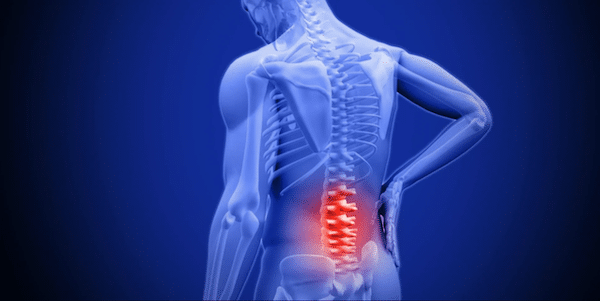

Oftentimes, when there is hip dysfunction, the low back has to work harder as a compensatory mechanism.
This is especially true when injuries last more than a few weeks.
It’s a good idea when dealing with chronic hip pain to see a health care specialist, including your local chiropractor, to evaluate your low back to ensure it’s functioning optimally while your hip is recovering.
What Stretches Can I Do At Home For My Hip?
Butterfly Stretch – Try this stretch seated on the floor or on a chair.
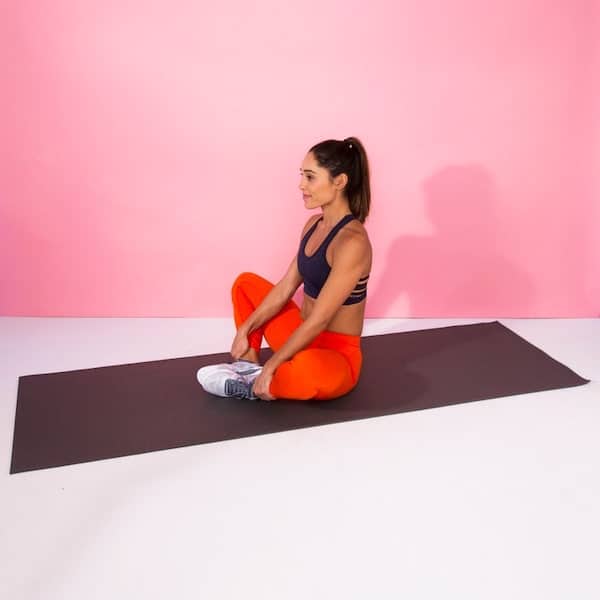

Consider utilizing the serene environment of Burnaby’s Central Park for your stretching routine. The peaceful setting can enhance the effectiveness of your stretches and contribute to your overall well-being.
Whichever position you choose, make sure you are sitting up nice and tall with your gaze forwards.
Then try to bring the soles of your feet together and hold your ankles to pull them closer to you, as far in as you can.
You should feel this stretch in the groin, inner thighs, and hips, and may even feel it around the muscles of the knees.
If you do not feel the stretch or need a deeper stretch, push your knees down gently with your elbows and/or try hinging at the hips forwards.
Hold the stretch for 5 deep breaths.
Seated Figure Four Stretch
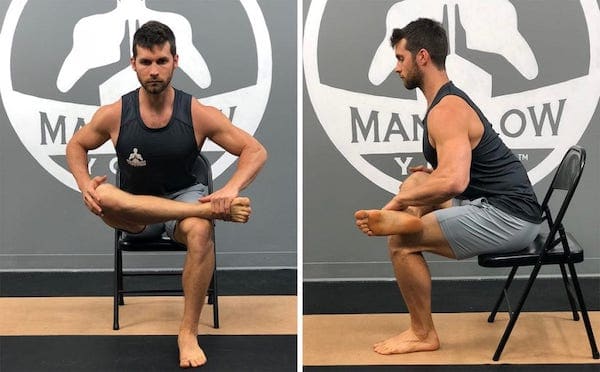

This stretch will help stretch the hip, low back and glute muscles.
Sit nice and tall on a firm chair to start, and then cross your right leg so that your right ankle rests on your left thigh.
At this point you should feel a deep stretch along the back of the right thigh into the buttocks.
If not, ensure you are still sitting up nice and tall as you exhale and hinge forwards at the hips and press down on the right knee.
Whatever your depth is in this stretch, hold the position for 5 deep breaths, and then switch to the other side and repeat.
Quad Stretch:


Start by standing beside a counter or a sturdy chair to hold on.
Take your left hand and try to reach for your left ankle. Ensure your left knee is pointing down and your thighs are parallel to each other.
You should feel this stretch at the front of your hips and thigh. Hold this stretch for 5 deep breaths.
TIP: If you cannot reach or hold your ankle with your hand, use a strap or a towel to loop around the ankle and pull up.
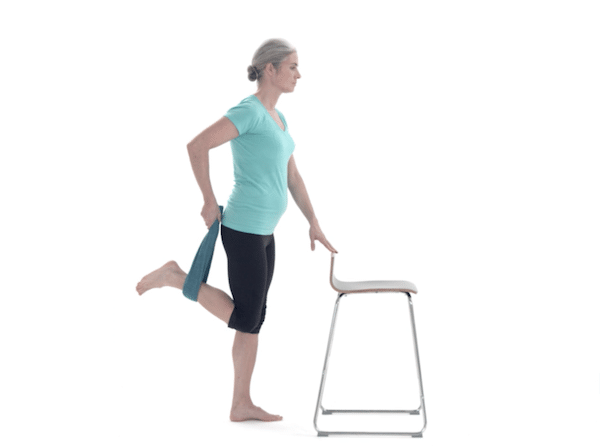

Pretzel Stretch:


Similar to the quad stretch but done by lying on your side to stretch your quads, hips, back, and obliques.
Start on the left side and rest your head on your left arm.
Bend your right knee up so that your hip and knee create a 90 degree angle, and let the inner side of your right knee rest on the floor.
Then bend your left knee back and try to grab your left ankle with your right hand.
Hold this position for 5 deep breaths.
TIP: if you cannot reach or hold your ankle with your hand, use a strap or a towel to loop around the ankle and pull up.
Hip Flexor Stretch:
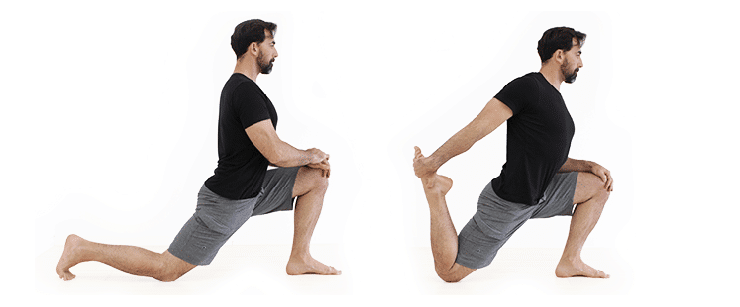

Floor Version
Kneel on the floor to start and then bring your right leg in front of you so that both legs are at a 90 degree angle, ensuring that your right foot is flat.
Next, engage your core and glutes as you keep your upper body straight, exhale and slowly push your hips forwards as you bring your weight slowly forwards so that your right knee is over your big toe (you may have to readjust the right foot forwards at this point).
Your left leg should now be greater than 90 degrees and continue to keep your spine straight.
Do not bend backwards or forwards, nor rest your upper body on the right thigh.
Hold this stretch for 5 deep breaths on each side. You should feel this stretch in the front of your hip and thigh.
MODIFIED VERSION:
Stand next to a firm support for balance such as a countertop or couch, holding on with your right hand for support step back with your left leg, inhale and reach up.
Then exhale, and push your hips forwards and lean slightly back and reach towards the right side.
Hold this stretch for 5 deep breaths on each side.
Be sure to check out Dr. Hafeez Merani’s Blog to learn more:
- What Happens If I Don’t Treat Plantar Fasciitis?
- What Else Can I Do To Help Relieve My Sciatic Pain?
- How To Alleviate Your Lower Back Pain
- How to choose the right chiropractor to help you with your whiplash
- How much do custom orthotics cost?
- How To Find an Amazing Chiropractor
Are you a Burnaby resident struggling with hip pain? Don’t let it diminish your quality of life. Visit our chiropractic clinic right here in Burnaby, BC. Our team is dedicated to providing you with personalized care that addresses the root cause of your pain, helping you return to your daily activities pain-free. Contact us today to book your appointment with our Burnaby chiropractor and take the first step towards a pain-free life.


